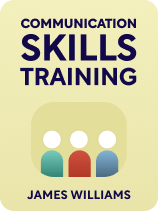

This article is an excerpt from the Shortform book guide to "Communication Skills Training" by James Williams. Shortform has the world's best summaries and analyses of books you should be reading.
Like this article? Sign up for a free trial here.
Do you tend to raise your voice or stop listening when you get frustrated? When you’re angry, do all of the right words come out in the right order?
Emotions are a huge part of life. So is communication. When emotions and communication come together, the message often gets lost. That’s why James Williams identifies emotional control as a core communication skill.
Continue reading to learn how to effectively handle emotions in communication.
Managing Emotions in Communication
Williams explains that emotional control is central to effective communication because, when we’re unable to control strong emotions, we tend to express ourselves poorly—for example, by yelling, making accusations, or failing to clearly explain our message. When we express ourselves in such ways, the other person will likely struggle to understand us, and they may even become offended and shut us out.
(Shortform note: The authors of Difficult Conversations add that effectively controlling and expressing your emotions is not only crucial to being understood by the other person but also to being able to understand them. They explain that when you bottle up your emotions, you end up distracted by your inner turmoil and focus on that rather than what the other person is saying.)
Here are four tips on how to control your own strong emotions in communication. These recommendations will also help you avoid triggering strong emotions in others.
Tip #1: Manage Your Emotional Triggers
Williams advises learning what types of situations and pet peeves trigger your strong emotions. That way, you can prepare for these situations in advance and catch yourself before you react emotionally. For example, when you anticipate a trigger, close your eyes and imagine petting your dog to calm yourself down.
(Shortform note: In Thanks for the Feedback, Douglas Stone and Sheila Heen agree that understanding your triggers is an important part of controlling strong emotions, particularly when receiving feedback. They elaborate that there are three types of triggers. Truth triggers are reactions to things we feel are wrong, unfair, or unhelpful. Relationship triggers are responses to the person we’re interacting with rather than the content of what they’re saying. Identity triggers are responses to situations that threaten our sense of self.)
Tip #2: Overcome Negative Assumptions
Often, we react emotionally due to negative assumptions we make about others and their intentions. For example, if someone’s tone seems demeaning to you, you might get angry and accuse them of patronizing you. To avoid this, Williams recommends replacing negative assumptions with positive ones. For instance, instead of patronizing you, maybe this person is trying to be gentle so they don’t hurt your feelings.
(Shortform note: This process of overcoming negative assumptions is part of a strategy called cognitive restructuring, which helps people overcome negative thought patterns in general. While it’s possible to complete this process on your own, experts explain that it’s best to practice first with a therapist—this will help you more effectively develop your restructuring skills so you can use them on your own in the future. One method of restructuring you can practice with a therapist is Socratic questioning—this teaches you to evaluate your negative assumptions to determine if they’re biased or illogical.)
If you can’t convince yourself of positive intent, avoid resentment by simply accepting that everyone is different and has their own flaws and characteristics—you can’t control people, so accept them for who they are.
(Shortform note: While accepting people’s flaws is an important part of relationships, experts advise being careful that you’re not taking this advice too far and inadvertently accepting abusive behaviors. This can be extremely damaging and result in conditions like PTSD. Signs of abuse include a partner or loved one belittling you, trying to isolate you from others, intimidating you verbally or physically, or making you feel like you’re always wrong.)
Tip #3: Write Out Your Thoughts
When you feel strong emotions like anger or stress, Williams says to write down your thoughts and feelings to release them. This will also help you determine how rational your emotional reactions are—writing helps you organize your thoughts so you can make a more accurate judgment on whether or not your feelings are reasonable.
(Shortform: Experts note that journaling has more benefits than just helping you rationalize and release your emotions. It can also help you take positive action toward your goals, make better decisions, and track your personal development.)
Tip #4: Be Respectful
When talking about your emotions, Williams recommends using “I feel” statements to express yourself—for example, “I feel hurt about what happened” or “I feel anxious about this situation.” This will help you avoid making unfair accusations, even when you’re angry or believe the other person’s at fault because you’re focusing on describing your emotions rather than the other person’s actions.
(Shortform note: Experts warn that for “I feel” statements to be effective, you must ensure you’re using them to describe your emotions, not to make assumptions about the other person’s intent. For example, don’t say “I feel like you were trying to belittle with that tone.” Instead, say “I felt belittled when you talked to me in that tone.” This statement avoids accusations and simply expresses that their actions hurt you, whether it was their intent or not.)
Further, focus on the issue at hand—don’t bring up unrelated past issues that you’re harboring negative emotions about. This could upset the other person and ignite negative emotions for you as well
(Shortform note: Bringing up past issues, a phenomenon called “kitchen-sinking,” is often the result of another communication issue called “gunnysacking”: harboring issues over time rather than handling them at the moment. Your frustration builds up until, eventually, it comes out during a moment of tension. To avoid gunnysacking and kitchen-sinking, discuss issues as they arise, and don’t avoid conflict.)
Exercise: Control Your Emotions
Williams explains that a crucial part of communicating effectively is being able to control strong emotions. In this exercise, consider a past experience involving strong emotions and identify techniques you can use to handle your feelings more effectively in the future.
- Think of a recent conversation where you experienced strong emotions that impacted your ability to communicate effectively. What emotion(s) did you feel, and what triggered you to feel that way? (For example, maybe you recently got annoyed at someone because you felt they were overexplaining. This led to you interrupting them, which offended them.)
- When encountering the trigger you identified above in the future, what steps can you take that will make you feel calmer? (For example, you can envision yourself floating in the ocean or cuddling with your cat.)
- Identify any negative assumptions that sparked your strong emotions. For each negative assumption, brainstorm a positive belief you can replace it with. (For example, if you assume the other person’s over-explaining because they think you’re stupid, consider that maybe they were just trying to be helpful and make sure you understood them completely.)

———End of Preview———
Like what you just read? Read the rest of the world's best book summary and analysis of James Williams's "Communication Skills Training" at Shortform.
Here's what you'll find in our full Communication Skills Training summary:
- Why effective communication is one of the most important skills to have
- How to develop your communication skills through intentional practice
- Why emotional control is central to expressing yourself effectively






